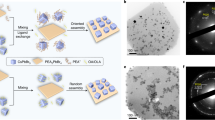Abstract
Two-dimensional layered ceramics, highly anisotropic materials in terms of structure and properties, were used to produce polymer-covered metal nanorods and metal microcrystals. The procedure took advantage of the intrinsic planar, layered ordering of the metal cations suitable to be reduced and could be further used to engineer one-dimensional metal alloy nanostructures by appropriate doping of the initial layered ceramic lattice with suitable cationic species. The procedure involved the formation in an intermediate step of a polymer-intercalated ceramic nanocomposite, highly porous to the diffusion of the polymerizable reducing agent, pyrrole. Two structurally similar layered bismuthates, Bi2Sr2CaCu2O8+δ and Bi6Sr2CaO12 and a partially Rh-substituted ceramic, Bi4Rh2Sr2CaO12 were used as the precursor layered ceramics and the reducible metal cations were Cu2+, Bi3+, and Rh3+, respectively. The formation of the polymer-covered metal nanorods and metal microcrystals took place at relatively high temperatures of reaction (325 °C) and long reaction times (10–12 days).
Similar content being viewed by others
References
R. Schoellhorn Materials and models: Faces of intercalation chemistry, in Progress in Intercalation Research, edited by W. Mueller-Warmuth and R. Schoellhorn (Kluwer Academic Publishers, Dordrecht, The Netherlands, 1994), p. 1.
A. Clearfield Intercalation chemistry of selected layered oxides and phosphates, in Progress in Intercalation Research, edited by W. Mueller-Warmuth and R. Schoellhorn (Kluwer Academic Publishers, Dordrecht, The Netherlands, 1994), p. 223.
P. Behrens, C. Panz, C. Kuehn, B. Pillep and A. Schneider Guest functionalized crystalline organic–inorganic nanohybrid materials, in Host–Guest Systems Based on Nanoporous Crystals, edited by F. Laeri, F. Schueth, U. Simon, and M. Wark (Wiley-VCH, Weinheim, Germany, 2003), p. 7.
S. Horiuchi and E. Takayama-Muromachi Crystal structure, in Bismuth-Based High-Temperature Superconductors, edited by H. Maeda and K. Togano (Marcel Dekker, Inc., New York, 1996), p. 7.
P. Conflant, J.C. Boivin and D. Thomas: Etude structurale du conducteur anionique Bi0,765Sr0,235O1,383. J. Solid State Chem. 35, 192 (1980).
X.-D. Xiang, S. McKernan, W.A. Vareka, A. Zettl, J.L. Corkill, T.W. Barbee III and M.L. Cohen: Iodine intercalation of a high-temperature superconducting oxide. Nature 348, 145 (1990).
X.-D. Xiang, W.A. Vareka, A. Zettl, J.L. Corkill, T.W. Barbee III, M.L. Cohen, N. Kijima and R. Gronsky: Tuning high-Tc superconductors via multistage intercalation. Science 254, 1487 (1991).
X.-D. Xiang, W.A. Vareka, A. Zettl, J.L. Corkill, T.W. Barbee III and M.L. Cohen: Epitaxial intercalation of the Bi–Sr–Ca–Cu–O superconductor series. Phys. Rev. B 43(13), 11496 (1991).
N. Kijima, R. Gronsky, X.-D. Xiang, W.A. Vareka, A. Zettl, J.L. Corkill, T.W. Barbee III and M.L. Cohen: Crystal structure of stage-1 iodine-intercalated superconducting IBi2Sr2CaCu2OxPhysica C 181, 18 (1991).
D.P. Scarfe, S. Bhavaraju and A.J. Jacobson: Iodine intercalation in the oxide-ion conductor BaBi8O13. Chem. Commun. 3, 313 (1997).
D.P. Scarfe and A.J. Jacobson: Iodine intercalation in the ionic conductor SrxBi9-xO(27-x)/2. Chem. Mater. 9, 3107 (1997).
W. Liang, J. Lei and C.R. Martin: Effect of synthesis temperature on the structure, doping level and charge-transport properties of polypyrrole. Synth. Met. 52, 227 (1992).
J. Lei, W. Liang and C.R. Martin: Infrared investigations of pristine, doped and partially doped polypyrrole. Synth. Met. 48, 301 (1992).
J. Lei, Z. Cai and C.R. Martin: Effect of reagent concentrations used to synthesize polypyrrole on the chemical characteristics and optical and electronic properties of the resulting polymer. Synth. Met. 46, 53 (1992).
T.V. Vernitskaya and O.N. Efimov: Polypyrrole: A conducting polymer: Its synthesis, properties and applications. Russ. Chem. Bull. 66, 443 (1997).
J. Kim, D. Sohn, Y. Sung and E.R. Kim: Fabrication and characterization of conductive polypyrrole thin film prepared by in situ vapor-phase polymerization. Synth. Met. 132, 309 (2003).
M.G. Kanatzidis, L.M. Tonge, T.J. Marks, H.O. Marcy and C.R. Kannewurf: In situ intercalative polymerization of pyrrole in FeOCl: A new class of layered, conducting polymer–inorganic hybrid materials. J. Am. Chem. Soc. 109, 3797 (1987).
L. Wang, J. Schindler, J.A. Thomas, C.R. Kannewurf and M.G. Kanatzidis: Entrapment of polypyrrole chains between MoS2 layers via an in-situ oxidative polymerization encapsulation reaction. Chem. Mater. 7, 1753 (1995).
R. Schweinfest, A.T. Paxton and M.W. Finnis: Bismuth embrittlement of copper is an atomic size effect. Nature 432, 1008 (2004).
CRC Handbook of Chemistry and Physics, edited by D.R. Lide (CRC Press, Boca Raton, FL, 1995), pp. 4–45.
CRC Handbook of Chemistry and Physics, edited by D.R. Lide (CRC Press, Boca Raton, FL, 1995), pp. 12–14.
Author information
Authors and Affiliations
Corresponding author
Rights and permissions
About this article
Cite this article
Pavel, A.C., Romanovicz, D.K., Yacaman, M.J. et al. Preparation of polymer-covered metal nanorods and metal microcrystals by intrinsic two-dimensional crystalline lattice templating. Journal of Materials Research 20, 3034–3046 (2005). https://doi.org/10.1557/JMR.2005.0377
Received:
Accepted:
Published:
Issue Date:
DOI: https://doi.org/10.1557/JMR.2005.0377




